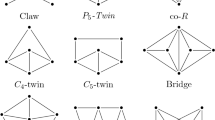Abstract
We consider a natural generalization of chordal graphs, in which every minimal separator induces a subgraph with independence number at most 2. Such graphs can be equivalently defined as graphs that do not contain the complete bipartite graph \(K_{2,3}\) as an induced minor, that is, graphs from which \(K_{2,3}\) cannot be obtained by a sequence of edge contractions and vertex deletions.
We develop a polynomial-time algorithm for recognizing these graphs. Our algorithm relies on a characterization of \(K_{2,3}\)-induced minor-free graphs in terms of excluding particular induced subgraphs, called Truemper configurations.
Access this chapter
Tax calculation will be finalised at checkout
Purchases are for personal use only
Similar content being viewed by others
Notes
- 1.
For a simpler example, consider the case when \(\mathcal F\) consists of all complements of cycles.
References
Blair, J.R.S., Peyton, B.: An introduction to chordal graphs and clique trees. In: George, A., Gilbert, J.R., Liu, J.W.H. (eds.) Graph Theory and Sparse Matrix Computation. The IMA Volumes in Mathematics and its Applications, vol. 56, pp. 1–29. Springer, New York (1993). https://doi.org/10.1007/978-1-4613-8369-7_1
Chudnovsky, M., Cornuéjols, G., Liu, X., Seymour, P., Vušković, K.: Recognizing Berge graphs. Combinatorica 25(2), 143–186 (2005). https://doi.org/10.1007/s00493-005-0012-8
Chudnovsky, M., Penev, I., Scott, A., Trotignon, N.: Excluding induced subdivisions of the bull and related graphs. J. Graph Theory 71(1), 49–68 (2012). https://doi.org/10.1002/JGT.20631
Chudnovsky, M., Seymour, P.: The three-in-a-tree problem. Combinatorica 30(4), 387–417 (2010). https://doi.org/10.1007/s00493-010-2334-4
Dallard, C., Milanič, M., Štorgel, K.: Treewidth versus clique number. III. Tree-independence number of graphs with a forbidden structure. J. Comb. Theory Ser. B 167, 338–391 (2024). https://doi.org/10.1016/j.jctb.2024.03.005
Diot, E., Radovanović, M., Trotignon, N., Vušković, K.: The (theta, wheel)-free graphs Part I: Only-prism and only-pyramid graphs. J. Combin. Theory Ser. B 143, 123–147 (2020). https://doi.org/10.1016/j.jctb.2017.12.004
Diot, E., Tavenas, S., Trotignon, N.: Detecting wheels. Appl. Anal. Discrete Math. 8(1), 111–122 (2014). https://doi.org/10.2298/AADM131128023D
Fellows, M.R., Kratochvíl, J., Middendorf, M., Pfeiffer, F.: The complexity of induced minors and related problems. Algorithmica 13(3), 266–282 (1995). https://doi.org/10.1007/BF01190507
Garey, M.R., Johnson, D.S., Miller, G.L., Papadimitriou, C.H.: The complexity of coloring circular arcs and chords. SIAM J. Algebraic Discret. Methods 1(2), 216–227 (1980). https://doi.org/10.1137/0601025
Hartinger, T.R.: New Characterizations in Structural Graph Theory: \(1\)-Perfectly Orientable Graphs, Graph Products, and the Price of Connectivity. Ph.D. thesis, University of Primorska (2017). https://www.famnit.upr.si/sl/studij/zakljucna_dela/download/532
Hartinger, T.R., Milanič, M.: Partial characterizations of 1-perfectly orientable graphs. J. Graph Theory 85(2), 378–394 (2017). https://doi.org/10.1002/jgt.22067
Kammer, F., Tholey, T.: Approximation algorithms for intersection graphs. Algorithmica 68(2), 312–336 (2014). https://doi.org/10.1007/s00453-012-9671-1
Korhonen, T., Lokshtanov, D.: Induced-minor-free graphs: Separator theorem, subexponential algorithms, and improved hardness of recognition. In: Woodruff, D.P. (ed.) Proceedings of the 2024 ACM-SIAM Symposium on Discrete Algorithms, SODA 2024, Alexandria, VA, USA, 7–10 January 2024, pp. 5249–5275. SIAM (2024). https://doi.org/10.1137/1.9781611977912.188
Lai, K.Y., Lu, H.I., Thorup, M.: Three-in-a-tree in near linear time. In: STOC 2020—Proceedings of the 52nd Annual ACM SIGACT Symposium on Theory of Computing, pp. 1279–1292. ACM, New York (2020). https://doi.org/10.1145/3357713.3384235
Lovász, L.: A characterization of perfect graphs. J. Comb. Theory Ser. B 13, 95–98 (1972). https://doi.org/10.1016/0095-8956(72)90045-7
Lovász, L.: Normal hypergraphs and the perfect graph conjecture. Discrete Math. 2, 253–267 (1972). https://doi.org/10.1016/0012-365X(72)90006-4
Maffray, F., Trotignon, N.: Algorithms for perfectly contractile graphs. SIAM J. Discrete Math. 19(3), 553–574 (2005). https://doi.org/10.1137/S0895480104442522
Milanič, M., Penev, I., Pivač, N., Vušković, K.: Bisimplicial separators. J. Graph Theory (2024, to appear). https://doi.org/10.1002/jgt.23098
Radovanović, M., Trotignon, N., Vušković, K.: The (theta, wheel)-free graphs Part II: structure theorem. J. Combin. Theory Ser. B 143, 148–184 (2020). https://doi.org/10.1016/j.jctb.2019.07.004
Acknowledgments
The authors are grateful to Nevena Pivač for helpful discussions. This work is supported in part by the Slovenian Research and Innovation Agency (I0-0035, research program P1-0285 and research projects J1-3001, J1-3002, J1-3003, J1-4008, J1-4084, N1-0102, and N1-0160, and BI-FR/22-23-PROTEUS-01), by the research program CogniCom (0013103) at the University of Primorska, by the French Fédération de Recherche ICVL (Informatique Centre-Val de Loire), by the LABEX MILYON (ANR-10-LABX-0070) of Université de Lyon, within the program Investissements d’Avenir (ANR-11-IDEX-0007) operated by the French National Research Agency (ANR), by Agence Nationale de la Recherche (France) under research grant ANR DIGRAPHS ANR-19-CE48-0013-01 and by H2020-MSCA-RISE project CoSP-GA No. 823748.
Author information
Authors and Affiliations
Corresponding author
Editor information
Editors and Affiliations
Rights and permissions
Copyright information
© 2024 The Author(s), under exclusive license to Springer Nature Switzerland AG
About this paper
Cite this paper
Dallard, C., Dumas, M., Hilaire, C., Milanič, M., Perez, A., Trotignon, N. (2024). Detecting \(K_{2,3}\) as an Induced Minor. In: Rescigno, A.A., Vaccaro, U. (eds) Combinatorial Algorithms. IWOCA 2024. Lecture Notes in Computer Science, vol 14764. Springer, Cham. https://doi.org/10.1007/978-3-031-63021-7_12
Download citation
DOI: https://doi.org/10.1007/978-3-031-63021-7_12
Published:
Publisher Name: Springer, Cham
Print ISBN: 978-3-031-63020-0
Online ISBN: 978-3-031-63021-7
eBook Packages: Computer ScienceComputer Science (R0)




